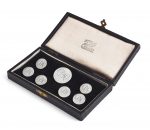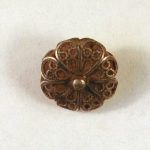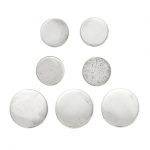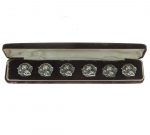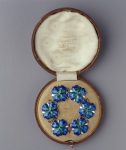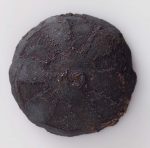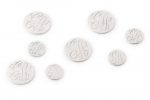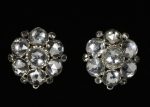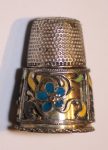Functional buttons with buttonholes for fastening or closing clothes appeared first in Germany in the 13th century. They soon became widespread with the rise of snug-fitting garments in 13th- and 14th-century Europe. Reference: Wikipedia
Below are some examples of silver buttons which have been used throughout history.
A set of seven George III Scottish silver buttons by James Cornfute of Perth, the largest with four marks; IC struck twice, double headed eagle struck twice, the six smaller buttons with four marks; IC, thistle, double headed eagle, monarch’s head Of plain circular form, all engraved with initials ‘PH’, diameter of largest 2.9cm, diameter of six smaller examples 1.9cm.
Sold for £ 400 inc. premium at Bonhams in 2016
Silver filigree biconvex button, constructed in two hemispheres soldered together of openwork filigree loops of twisted and plain silver wires; with central knop on one upper side, remains of an attachment loop at the other.
16th Century
Reference: © The Trustees of the British Museum
Seven Sterling Silver Blazer Buttons, Cartier Signed Cartier. With signed fitted box.
Sold for $125 (includes buyer’s premium) at Doyle New York in 2011
Art Nouveau Sterling Silver Six Buttons Set, Circa 1905. Each button with a nymph. Original fitted case. Marked with English import marks for London, dated 1905, importer mark for Robert Friedrich. Diameter: 2.5cm.
Sold for $170 at Pasarel in 2019
Six buttons; enamelled sterling silver, each button is a four-leaf clover shape; deep blue enamel graduating to green in the middle; each leaf out lined in silver. The buttons are to be attatched with round toggles – brass, with silver ends. These buttons are classic Art Nouveau in style. Made in Birmingham 1909 by “J.F” or “J.I”. In round brown leather box, velvet & satin lined.(LC).
Reference: Museum of Applied Art and Sciences
Hemispherical silver button.
Button Nubian Classic Kerma about 1700–1550 B.C.
Reference: Museum of Fine Arts Boston
A SET OF EIGHT SILVER BUTTONS, MAKER’S MARK EM, PROBABLY FOR EDMUND MILNE, PHILADELPHIA, CIRCA 1780 comprising four large and four small, engraved with script initals GW. each marked twice on back EM in rounded rectangle. diameters 7/8 and 9/16 in. 2.2 cm; 1.4 cm
Sold for 4,063 USD at Sothebys in 2015
Pair of buttons decorated with rose-cut rock crystals, set in silver, with enamel decoration on the reverse. Circa 1690
Reference: © Victoria and Albert Museum
